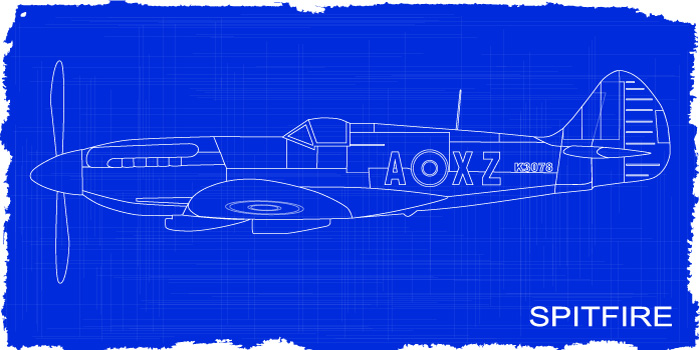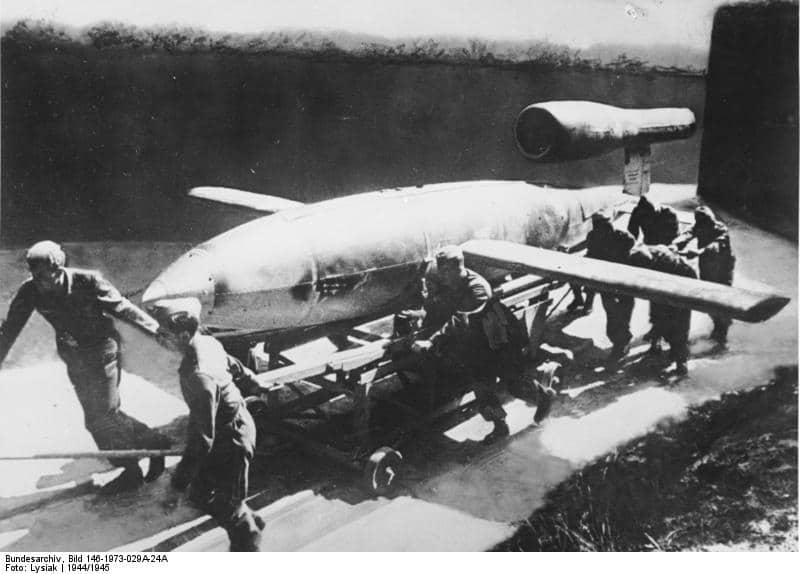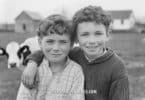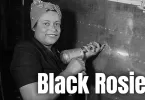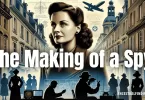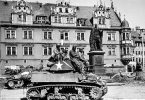The Supermarine Spitfire was the iconic British aircraft of the Second World War and perhaps the most famous aircraft of the entire war of any of the participating nations. It formed the backbone of the Royal Air Force (RAF) following the Battle of Britain in 1940 and consistently outperformed many of its opponents. Its performance and importance cannot be understated and the romantic notions it inspired, with its distinctive elliptical wing shape and the throaty roar of its Merlin engines, are still deeply embedded in the national psyche of the British people to this day.
The men who flew these planes were like the knights of medieval times, seated on their powerful war horses and often engaging an equally skilled enemy in a one on one confrontation, often resulting in the death of one of them.
The first test flight of a Spitfire took place on March 5, 1936, and was born of the need for a fast interceptor fighter which could take on enemy bombers and shoot them down before they reached their intended targets. It was an era when large-scale bombing of military and civilian targets was becoming a very real possibility and the RAF High Command had already envisioned that this would form a part of any future war. The fear of cities laid to waste by waves of unstoppable bombers was something which offered many sleepless nights.
As it turned out they were right. The new and modern aircraft of the German Luftwaffe demonstrated this potent threat when they destroyed the Spanish city of Guernica in 1937 and, although this was a small raid in comparison with what was to come, it served as a reminder of the threat and the need for a way to face it.
But it wasn’t until mid-1938, and 24 months after the initial order had been placed, that production of the new fighter saw the first operational units being delivered. This, it transpired, was probably just in the nick of time, as the aircraft were able to be tested and experienced by many pilots before they would have to be flown in combat missions.
During World War II the production of the Spitfire increased and around 20,000 were eventually built. The £12,000 price tag for each machine was hefty, but it was to pay dividends in the coming years as Britain reeled from successive blows from a far better equipped Germany.
The Spitfire remains as the only British fighter plane to have been in constant production throughout the course of the war and it remained in active service until it was eventually retired from the Irish Air Corps in 1955, with more than 30 nations employing it and its variants at times.
WWII
With the outbreak of war with Germany on 3rd September 1939, the Spitfire was soon on the front lines and the first reported ‘kill’ from one of the aircraft was when it shot down a Heinkel 111 over the Firth of Forth in eastern Scotland.
As the war progressed, from the Phoney War following the defeat of Poland, through to the German invasion of France and the Low Countries, the Spitfire slowly but surely began to take on an ever greater role, and by the summer of 1940 the new mark II models were beginning to make an appearance in the skies over Britain.
With more armor to protect the pilot and a better engine, the Mark II could climb faster than the original version of the aircraft, giving it an advantage over its competition and other Allied designs.
The Battle of Britain
With France and the Low Countries defeated by June of 1940, it was left to Britain to carry the fight alone. At that time it was impossible for the British army, following the near disaster of Dunkirk, to have contemplated taking on the Germans in a large-scale land engagement. They had now been defeated twice in campaigns on mainland Europe, in Norway and in France, and they would soon be forced into another ignominious retreat when the Germans invaded Greece in 1941.
It was, thus, left to the Royal Navy, which was far stronger than their German counterparts, and the Royal Air Force to provide morale-boosting victories to give the British public something to cheer.
Unfortunately for the RAF, in 1940 they were still vastly outnumbered by the German Luftwaffe, which could muster a grand total of some 4,000 aircraft of various designs by July 1, 1940. Although not all of these aircraft were employed in the Battle of Britain they still heavily outnumbered the RAF fighters, which stood at just 900 of all types.
Of these 900 fighters, only some 250 were Spitfires as they were less numerous than the Hawker Hurricanes, which were of a comparable age but could be produced much faster.
When it came, the Battle of Britain was a bloody and violent campaign which left cities in ruin, thousands of civilians dead and injured and even greater numbers of homeless. The German High Command was acutely aware, as was the British, that in order to be able to execute a successful invasion of the British Isles they would first have to have command of the skies.
The RAF pilots, who took to the air in the Spitfires, Hurricanes and others, less well-known fighters faced enormous odds and a life expectancy which was miserly at best. That they achieved what they did remains a testament to their bravery and skill.
The Germans began the Battle of Britain by assuming that they could obtain air supremacy in no more than 4 weeks. On June 26, 1940 the Luftwaffe began its campaign by carrying out probing attacks. This was followed up by attacks on shipping and airfields, as well as aircraft manufacturing in mid-July and then with an increased intensity of attacks from mid-August until the beginning of September.
During this time the Spitfire was generally employed against the excellent Messerschmitt Bf 109 as it was deemed to be superior to the Hurricane. This allowed the more numerous Hurricanes to target the waves of bombers.
The Spitfire’s work against the 109’s of the Luftwaffe was part of the reason for it achieving its legendary status during the Battle of Britain. Despite there being little to choose between the two machines (in fact, the Bf 109 was slightly faster) the Spitfires managed to retain a slight advantage in victories. This was due to several factors, including the organization of the RAF which allowed for proper rest for pilots, the fact that the defenders could wait until the last moments before taking to the air and their ability to be repatriated if shot down over their own territory.
Other new innovations, like radar, also helped, but the fact remained that the Spitfire was a potent weapon and when handled by an experienced pilot it was likely to come out on top in the majority of occasions. All of this contributed to the attrition rate of Spitfires being lower than that of the Hurricanes and other units when it came to a one on one dogfight with an enemy aircraft.
As the Luftwaffe began to incur serious losses and began to weaken, they saw the opportunity to attack major urban centers as being the way to proceed and, just as the RAF were beginning to feel the effects of sustained attacks on airfields, losses in trained crew and fighters, they were suddenly given the reprieve of what became known as The Blitz.
Now, with breathing space for the pilots, they were able to regroup and the Spitfire squadrons exacted a heavy toll on the attackers at every opportunity. Other ideas such as the ‘Spitfire Fund’ set up by Lord Beaverbrook, meant that ordinary people could contribute to buying their own Spitfire and these savings raised more than £13 million, an astronomical sum of money in those days and enough to build over 1000 of the aircraft.
As the reality of the situation set in, Hitler was forced to abandon his plans to invade Britain and relied on sporadic bombing raids to harass the civilian population and armaments industry. The victory for the British, during the Battle of Britain, and the performance of the Spitfire, in particular, was what pushed it to the very forefront of the public’s admiration.
Performance
When it came to performance it was generally accepted that the Spitfire was the best British fighter of the war and among the best aircraft from any side, with one-two notable exceptions.
With a good pilot, it could certainly match anything in the European and African theaters and remained as such until the Germans could employ their new jet-propelled aircraft much later in the war, by which time it was too late.
Other Theaters and Other Uses
Following the success of the Spitfire during the Battle of Britain, it went on to be employed in other theaters. It was used in the conflict in the Mediterranean, where it took on the defense of Malta and caused enormous casualties to the Italian air force, before leading the invasion of Sicily and Italy in 1943.
In the Far East, the Spitfire saw service in the defense of Singapore, where the RAF pilots encountered the impressive Japanese Zero. The Zero, it turned out, proved to be a match for the Spitfire, with its better turning circle and ability to climb at a steep angle.
Spitfire pilots were forced to adapt to this shock by using a hit and run tactic, then using their superior speed and diving ability to avoid classic dogfight situations.
Despite the limitations, they experienced against the Zero, and the fact that they remained outnumbered by them due to the low priority offered to that theatre, the Spitfire still performed well in Asia and helped to defend Darwin against bombing raids in 1942.
The aircraft was also used by the Royal Canadian Air Force throughout the war, the USAAF until 1943 and in significant numbers by the Soviet Union on the Eastern Front.
As the war progressed, new jobs were found for the planes, including in a reconnaissance role far behind enemy lines. Their speed made them ideal for this type of role and it was a Spitfire which confirmed the existence of the German V weapons in 1943.
Defending London From V Weapons
As the war raged on in Europe and beyond, the Germans began resorting to the V weapons to try to tip the balance back in their favor. The V-1’s, or doodlebugs, which were the original ballistic missiles but were slow and could occasionally be shot down, but Spitfire pilots soon develop their own methods for dealing with the menace.
Flying alongside the weapons they would position their win tip under the wing of the flying bomb and then tip it to one side, fouling the delicate navigational systems inside it and causing it to crash. This tactic was successful on many occasions but was useless against the V-2 when it made its first appearance.
This supersonic weapon could not be caught by a Spitfire, or any other aircraft and often the only knowledge of it came when it hit a target and exploded.
Notable Pilots
Well-known Spitfire pilots included ‘Johnnie’ Johnson who shot down a total of 34 enemy aircraft during a career which saw him piloting Spitfires right through until 1945.
Douglas Bader, who became famous after losing his legs in an accident in 1931, was another who flew the aircraft and shot down 20 enemy planes before he himself was downed over France in 1941, The loss of his legs did not prevent Bader from making escape attempts and was eventually incarcerated in the infamous Colditz Castle.
But pilots came from all over the British Empire and indeed from beyond. An entire fighter wing of Polish airmen made a significant contribution to the fighting effort, as well as men from France, Belgium, Czechoslovakia, and many others.
The Supermarine Spitfire was the iconic British aircraft of the Second World War and perhaps the most famous aircraft of the entire war of any of the participating nations.
Variants
Because of the success of the Spitfire, it continued to be adapted and improved and several variants sprang up from the original design, changing engines and armaments in response to changing needs. The Supermarine Seafire was essentially a Spitfire which had been adapted to operate from an aircraft carrier. This aircraft proved to be better than the Japanese Zero but it became available too late in the war to have made any significant difference.
Since World War II
Following the war, the Spitfire continued to serve in the air forces of several nations, although with the advent of the jet age its days were quite clearly numbered. Indeed the Germans had developed a jet aircraft towards the end of the war which was the better of any propeller driven plane and it was only because of the low numbers produced that they failed to make a greater impact.
The final operational flights of Spitfires in the RAF came in 1955, but it carried on working until 1961 when it was finally retired from the Irish Air Corps. Today there are around 55 of the aircraft which still have the ability to fly, mainly kept in the air by a small army of enthusiasts who are determined to keep alive the memories of this iconic aircraft.

